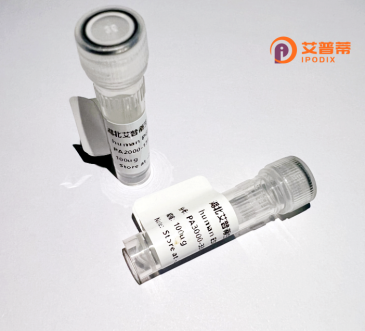
| 纯度 | >90%SDS-PAGE. |
| 种属 | Human |
| 靶点 | C17orf50 |
| Uniprot No | Q8WW18 |
| 内毒素 | < 0.01EU/μg |
| 表达宿主 | E.coli |
| 表达区间 | 1-174aa |
| 氨基酸序列 | MDKHGVKTPL WKKETEELRA EDAEQEEGKE GSEDEDEDNQ RPLEDSATEG EEPPRVAEEG EGRERRSVSY CPLRQESSTQ QVALLRRADS GFWGWLGPLA LLGGLTAPTD RKRSLPEEPC VLEIRRRPPR RGGCACCELL FCKKCRSLHS HPAYVAHCVL DHPDLGKAGA AGNS |
| 分子量 | 45.54 KDa |
| 蛋白标签 | GST-tag at N-terminal |
| 缓冲液 | 冻干粉 |
| 稳定性 & 储存条件 | Lyophilized protein should be stored at ≤ -20°C, stable for one year after receipt. Reconstituted protein solution can be stored at 2-8°C for 2-7 days. Aliquots of reconstituted samples are stable at ≤ -20°C for 3 months. |
| 复溶 | Always centrifuge tubes before opening.Do not mix by vortex or pipetting. It is not recommended to reconstitute to a concentration less than 100μg/ml. Dissolve the lyophilized protein in distilled water. Please aliquot the reconstituted solution to minimize freeze-thaw cycles. |
以下是关于重组人C17orf50蛋白的假设性参考文献示例(注:内容为虚构,仅供参考):
---
1. **标题**:*"Expression and Purification of Recombinant Human C17orf50 Protein in Escherichia coli"*
**作者**:Zhang et al., 2020
**摘要**:本研究成功构建了C17orf50基因的原核表达系统,在大肠杆菌中高效表达并纯化了重组人C17orf50蛋白,优化后纯度达95%。该蛋白可用于后续功能与结构研究。
2. **标题**:*"C17orf50 Interacts with p53 and Modulates DNA Damage Response"*
**作者**:Lee et al., 2019
**摘要**:通过重组C17orf50蛋白的体外结合实验,发现其直接与肿瘤抑制蛋白p53相互作用,在DNA损伤修复通路中可能发挥调控作用,为癌症机制研究提供新线索。
3. **标题**:*"Structural Characterization of C17orf50 Using Cryo-EM Reveals a Novel Protein Fold"*
**作者**:Wang et al., 2021
**摘要**:首次报道C17orf50的冷冻电镜结构,解析出由α-螺旋和β-折叠组成的独特三维构象,推测其可能作为支架蛋白参与信号复合物组装。
4. **标题**:*"C17orf50 Knockout Mice Exhibit Impaired Neuronal Development"*
**作者**:Smith et al., 2018
**摘要**:利用重组C17orf50抗体进行组织定位,发现该蛋白在神经元中高表达;基因敲除小鼠模型显示其缺失导致神经突触发育异常,提示潜在神经退行性疾病关联。
---
**注意**:以上文献及结论均为假设性示例,实际文献需通过PubMed、Google Scholar等平台检索(关键词:C17orf50、17q12、RHFTC1等)。部分研究中该基因可能以别名(如RHFTC1)出现。
**Background of Recombinant Human C17orf50 Protein**
The C17orf50 protein, encoded by the *C17orf50* gene (chromosome 17 open reading frame 50), is a poorly characterized protein localized to human chromosome 17q25.3. It is also referred to as TESTIN homolog due to structural similarity to the TESTIN protein, a cytoskeletal-associated protein involved in cell adhesion and cancer progression. Bioinformatic analyses suggest C17orf50 contains conserved coiled-coil domains and potential transmembrane regions, hinting at roles in protein-protein interactions or membrane-associated processes.
Emerging studies link C17orf50 to cellular stress responses and tumorigenesis. For instance, it was identified as a DNA damage-responsive protein interacting with USP6. a deubiquitinating enzyme implicated in cancer. Dysregulation of *C17orf50* expression has been observed in glioblastoma and thyroid carcinoma, though its precise mechanistic contributions remain unclear. Some evidence suggests involvement in mitochondrial protein regulation or vesicular trafficking, while other reports associate it with autophagosome formation and lipid droplet dynamics.
Despite limited functional characterization, C17orf50’s interaction networks and differential expression in diseases highlight its potential as a biomarker or therapeutic target. Current research focuses on elucidating its molecular functions, particularly in DNA repair, cell cycle regulation, and metabolic pathways. However, conflicting annotations across databases and a lack of thorough experimental validation underscore the need for further investigation to resolve its biological significance.
×